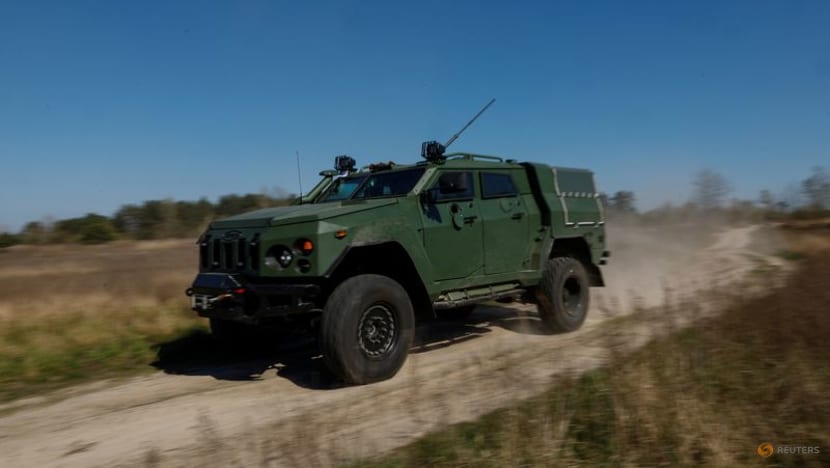Ukraine ramps up domestic arms production as troops face weapons shortage on battlefield
Ukraine will be spending up to US$6 billion on weapons production this year to meet urgent needs on the frontlines.

An employee tests a Novator armoured personnel carrier at a testing facility of the 'Ukrainian Armor' Design and Manufacturing Company, amid Russia's attack on Ukraine, in an undisclosed location in Ukraine April 9, 2024. REUTERS/Valentyn Ogirenko

This audio is generated by an AI tool.
KYIV: Ukraine is rushing to manufacture more arms domestically, as its troops face shortages of weapons on the frontlines.
It will be spending up to US$6 billion on weapons production this year to meet the urgent need, after long delays in western military aid.
This comes as Russia’s expanded defence spending has given it an edge on the battlefield, with its forces continuing to advance in the northeast.
SCRAMBLING TO PRODUCE MORE WEAPONS
Ukraine has no choice but to pump out more weapons, and faster than ever before, with big factories and even homes being used in the country’s fast-expanding military industrial complex.
When CNA visited one factory in an undisclosed location in the Kyiv region, armoured infantry vehicles were getting their final touches on the assembly line.
Ukrainian Armor, the defence industry company operating it, said production has increased significantly since Russia launched its full-scale invasion in February 2022.
The firm is behind the multi-purpose armoured vehicle Novator, built to protect troops from shrapnel and small arms fire.
“For vehicles, we expanded more than 10 times,” said Ukrainian Armor director-general Vladislav Belbas.
“In 2023, we started to produce each month the same quantity as we produced in (the whole of) 2022. So it’s quite significant. And this year, compared to 2023, we plan to expand approximately three times.”
However, arms production during wartime is a risky business, said observers, adding that the expansion also brings a greater threat of attacks.
Facilities scrambling to make weapons are often targets of Russian shelling, and each step of the assembly process has to be done at different locations.
At a warehouse where mortar launchers are made, assembled items are immediately sent to the battlefield.
The company manufacturing them said production has expanded by 50 per cent since last year.
Related:
PLAYING CATCH UP
Ukraine said its military industrial complex is on track to produce US$20 billion worth of arms this year. But it only has enough funds to pass US$6 billion worth of contracts, and needs local funding and its western partners to finance the rest.
Businesses are also innovating and contributing to the war machinery by bolstering the country’s economy.
For Kyiv, reforming the defence industry would help make its future integration into the North Atlantic Treaty Organization and the European Union smoother.
Yet, the task of churning out more weapons also concerns survival, said observers.
Russian forces now have the upper hand, after military aid from the United States stalled for six months, and Kyiv has to play catch up.
In 1994, three years after its independence, Ukraine gave up its arms and nuclear arsenal – the third largest in the world at the time – to Russia in exchange for security assurances that its territorial sovereignty would be respected.
“Ukraine was supposed to be a peaceful country protected by the Budapest Memorandum,” said retired Ukrainian colonel Serhiy Grabskyy, referring to the 1994 agreement.
“No one expected that something would happen, but the situation changed in 2014, when we faced a real challenge of aggression from the Russian federation,” he added. In 2014, Russia annexed Crimea from Ukraine, paving the way for today’s war.
DRONES CHANGING WARFARE
Ukraine has turned to its drone industry to make up for its shortfalls.
At a factory owned by Ukrainian unmanned aerial systems manufacturer Skyeton, for instance, expensive chips and sensors are fitted to a long-range surveillance drone known as the Raybird.
The company said 95 per cent of its drones, used for civilian applications such as 3D mapping, are now involved in the country’s defence. Production has also gone up sevenfold, it added.
Its drones are able to fly hundreds of kilometres to collect crucial data on Russian supply lines.
Skyeton founder and CEO Alexander Stepura said: “If we do not destroy this area where they collect resources, we cannot change the frontline situation, the position on the frontline. Because they have much more resources than we have.”
Related:
On the frontlines, first-person view drones – which are low-cost, easy to assemble, and remotely-controlled from the safety of a bunker – have flooded the skies.
Thousands of these unmanned aerial vehicles have been used for reconnaissance, and to drop explosives on enemy positions.
Many Ukrainians, including software engineers, filmmakers, and entrepreneurs, have been making the drones at home and delivering them to troops on the battlefield.
A software engineer, who only gave his name as Denys, said: “We decided to assemble the drones, so we can directly help the guys who are serving in the army to be more effective.”














